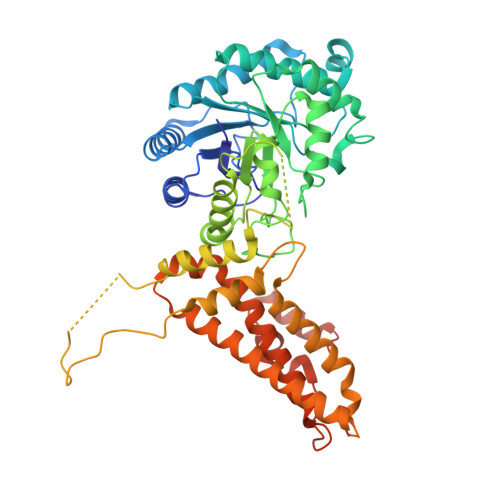Discovery and clinical translation of ceperognastat, an O-GlcNAcase (OGA) inhibitor, for the treatment of Alzheimer's disease.
Kielbasa, W., Goldsmith, P., Donnelly, K.B., Nuthall, H.N., Shcherbinin, S., Fleisher, A.S., Hendle, J., DuBois, S.L., Lowe, S.L., Zhang, F.F., Woerly, E.M., Dreyfus, N.J., Evans, D., Gilmore, J., Mancini, M., Constantinescu, C.C., Gunn, R.N., Russell, D.S., Collins, E.C., Brys, M., Hutton, M.L., Mergott, D.J.(2024) Alzheimers Dement (N Y) 10: e70020-e70020
- PubMed: 39748851
- DOI: https://doi.org/10.1002/trc2.70020
- Primary Citation of Related Structures:
9BA8, 9BA9 - PubMed Abstract:
The aggregation and spread of hyperphosphorylated, pathological tau in the human brain is hypothesized to play a key role in Alzheimer's disease (AD) as well as other neurogenerative tauopathies. O-GlcNAcylation, an important post-translational modification of tau and many other proteins, is significantly decreased in brain tissue of AD patients relative to healthy controls. Increased tau O-GlcNAcylation has been shown to reduce tau pathology in mouse in vivo tauopathy models. O-GlcNAcase (OGA) catalyzes the removal of O-GlcNAc from tau thereby driving interest in OGA inhibition as a potential therapeutic approach to reduce tau pathology and slow the progression of AD. A multidisciplinary approach was used to identify ceperognastat (LY3372689) as a potent OGA inhibitor, including an extensive discovery effort with synthetic chemistry, structure-based drug design, and in vivo OGA enzyme occupancy studies. Preclinical studies assessed the target engagement, inhibition of OGA enzyme activity, OGA enzyme occupancy, and changes in tau O-GlcNAc. Four clinical Phase 1 studies of ceperognastat in healthy participants were performed to assess clinical safety and tolerability, pharmacokinetics (PK), and enzyme occupancy. Ceperognastat is a potent, central nervous system (CNS)-penetrant, low-dose inhibitor of OGA, which can achieve > 95% OGA enzyme occupancy in animal and human brain. Overall, ceperognastat had an acceptable safety profile in Phase 1 clinical studies with no serious adverse events reported following single and multiple dosing. The PK, enzyme occupancy, and safety profile supported Phase 2 development of ceperognastat. Ceperognastat is an orally available, highly potent, CNS-penetrant OGA inhibitor that achieved high (> 80%) OGA enzyme occupancy and increased brain O-GlcNAc-tau preclinically. Ceperognastat demonstrated > 95% OGA enzyme occupancy in Phase 1 trials. These occupancy data informed the dose selection for the Phase 2 clinical program. Ceperognastat is a highly potent, CNS-penetrant OGA inhibitor.Ceperognastat is both orally available and CNS-penetrant even when given at low doses.Ceperognastat can achieve > 95% OGA enzyme occupancy in the animal and human brain.Ceperognastat had an acceptable safety profile in Phase 1 clinical studies.
- Eli Lilly and Company Indianapolis Indiana USA.
Organizational Affiliation:

















